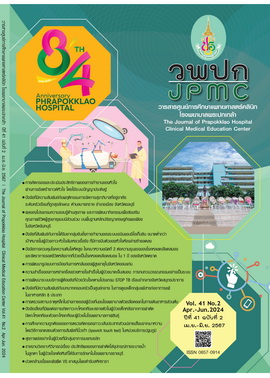Validation of the Ipswich Touch Test for Diabetic Peripheral Neuropathy Screening in Primary Care
Main Article Content
Abstract
BACKGROUND: Diabetic foot, a severe complication of diabetes, significantly impairs the quality of life for affected individuals. However, it can be prevented through screening for loss of protective sensation in the foot. Currently, standard screening methods still require specialized equipment and trained medical professionals.
OBJECTIVES: This study aims to assess the accuracy of screening for diabetic peripheral neuropathy by comparing the Ipswich touch test with the 10-g monofilament test in patients diagnosed with type 2 diabetes.
METHODS: This diagnostic study with a cross-sectional design focused on a group of 274 patients with type 2 diabetes who were receiving services at Nong Khantee Sub-district Health Promoting Hospital in Phra Phutthabat District, Saraburi Province. Participants underwent both the Ipswich touch test and the 10-g monofilament test. Statistical analysis included the evaluation of sensitivity, specificity, negative predictive value, positive predictive value, negative likelihood ratio, positive likelihood ratio, and Cohen’s kappa statistic to assess the diagnostic reliability of the Ipswich touch test.
RESULTS: The majority of patients were women, accounting for 64.2%, with an average age of 62.5 years. When compared to the 10-g monofilament test, the accuracy of the Ipswich touch test showed a sensitivity of 73.4%, specificity of 99.0%, positive predictive value of 95.9%, negative predictive value of 92.4%, positive likelihood ratio of 77.11, and negative likelihood ratio of 0.27. The Kappa index, indicating agreement, was 0.79 (p <0.001).
CONCLUSIONS: The Ipswich touch test exhibited good sensitivity, high specificity, and concordance with the 10-g monofilament test, suggesting its potential application for screening diabetic peripheral neuropathy, especially in primary healthcare units where equipment is limited.
ClinicalTrials.gov Identifier, NCT06288555
Article Details

This work is licensed under a Creative Commons Attribution-NonCommercial-NoDerivatives 4.0 International License.
References
International Diabetes Federation. Diabetes Facets and Figures [Internet]. 2023 [cited 2023 Oct 22]. Available from: https://idf.org/about-diabetes/diabetes-facts-figures/
Department of Disease Control. World diabetes day campaign 2021: emphasizing the importance of diabetes care to ensure widespread treatment [Internet]. 2021 [cited 2023 Oct 22]. Available from: https://ddc.moph.go.th/brc/news.php?news=21692&deptcode=brc
Leelawattana R, Pratipanawatr T, Bunnag P, Kosachunhanun N, Suwanwalaikorn S, Krittiyawong S, et al. Thailand diabetes registry project: prevalence of vascular complications in long-standing type 2 diabetes. J Med Assoc Thai 2006:89 Suppl 1:S54-9.
Thirapatarapong W, Srisawasdi G. Epidemiology and direct costs of diabetes related lower extremity amputations at Siriraj hospital. The ASEAN Journal of Rehabilitation Medicine 2008;18:65-9.
Rerkasem K, Kosachunhanun N, Tongprasert S, Khwanngern K, Matanasarawoot A, Thongchai C, et al. The development and application of diabetic foot protocol in Chiang Mai university hospital with an aim to reduce lower extremity amputation in Thai population: a preliminary communication. Int J Low Extrem Wounds 2007;6:18-21.
Ministry of Public Health. Clinical practice guideline: prevention and management of diabetic foot complications. Nonthaburi: Medical Research and Technology Assessment Institute; 2013.
Moxey PW, Gogalniceanu P, Hinchliffe RJ, Loftus IM, Jones KJ, Thompson MM, et al. Lower extremity amputations--a review of global variability in incidence. Diabet Med 2011;28:1144-53.
Gibson TB, Driver VR, Wrobel JS, Christina JR, Bagalman E, DeFrancis R. Podiatrist care and outcomes for patients with diabetes and foot ulcer. Int Wound J 2014;11:641-8.
Diabetes Association of Thailand. Clinical practice guideline for diabetes 2023. Bangkok: Diabetes Association of Thailand; 2023.
Sharma S, Kerry C, Atkins H, Rayman G. The Ipswich Touch Test: a simple and novel method to screen patients with diabetes at home for increased risk of foot ulceration. Diabet Med 2014;31:1100-3.
Sudjai N. Sample size calculation for diagnostic test studies. Journal of Medicine and Health Sciences 2020;27(2):167-82
Bowling FL, Abbott CA, Harris WE, Atanasov S, Malik RA, Boulton AJ. A pocket-sized disposable device for testing the integrity of sensation in the outpatient setting. Diabet Med 2012;29:1550-2.
Dutra LMA, Moura MC, do Prado FA, De Oliveira Lima G, Melo MC, Fernandez RNM, et al. Is it possible to substitute the monofilament test for the Ipswich Touch Test in screening for peripheral diabetic neuropathy? Diabetol Metab Syndr [Internet]. 2020 [cited 2023 Oct 22];12:27. Available from: https://www.ncbi.nlm.nih.gov/pmc/articles/PMC7110690/pdf/13098_2020_Article_534.pdf
Rayman G, Vas PR, Baker N, Taylor CG Jr, Gooday C, Alder AI, et al. The Ipswich Touch Test: a simple and novel method to identify in patients with diabetes at risk of foot ulceration. Diabetes Care 2011;34:1517-8.

